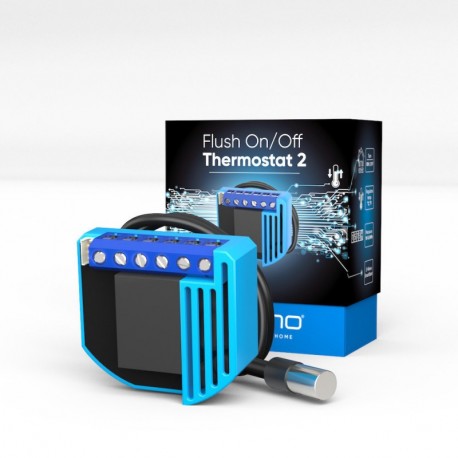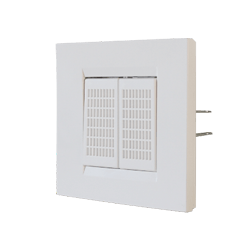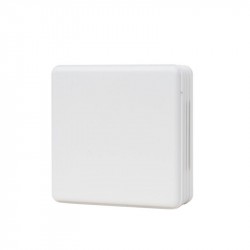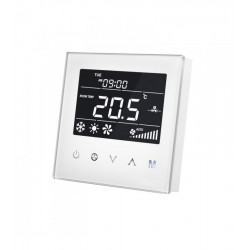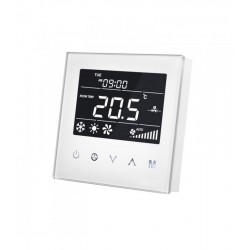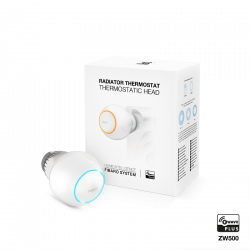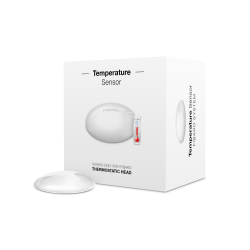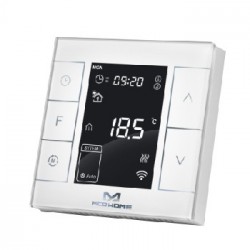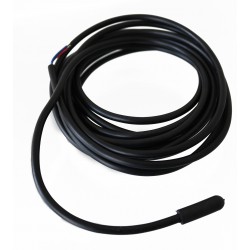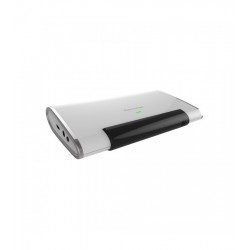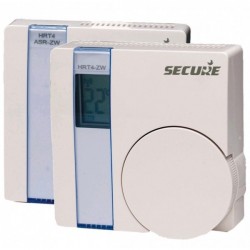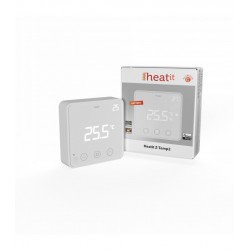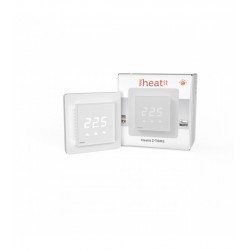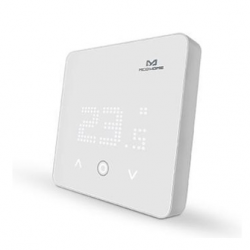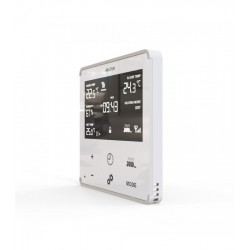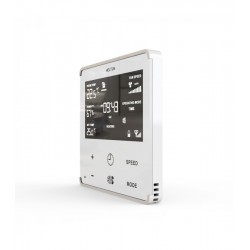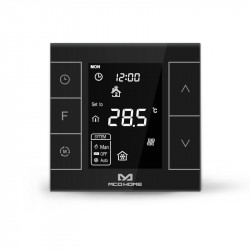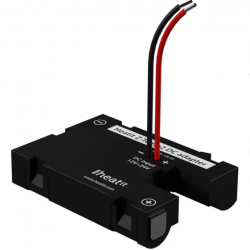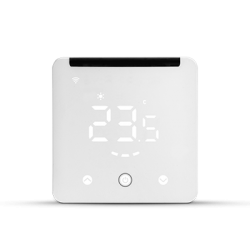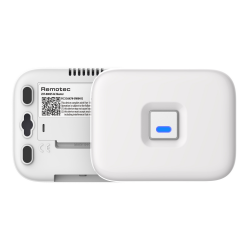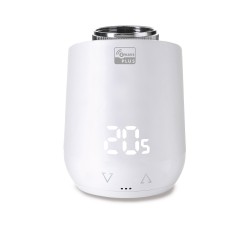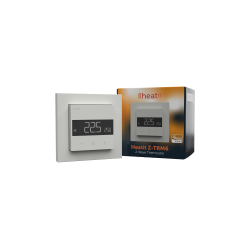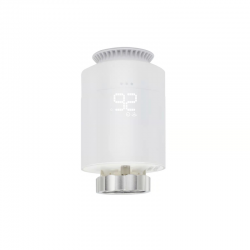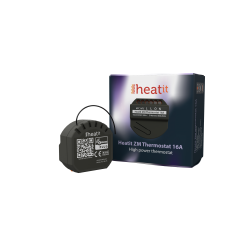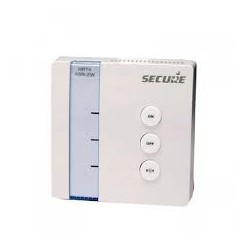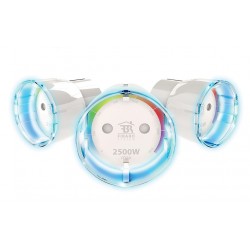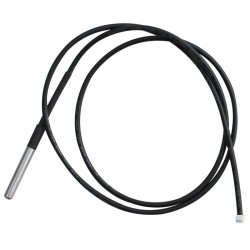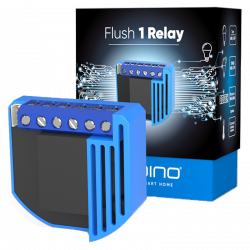Sem produtos
Preços com IVA
Produto adicionado com sucesso ao seu carrinho de compras
Existem 0 produtos no seu carrinho de compras. Existe um produto no seu carrinho de compras.
Qubino Flush On / Off Thermostat 2 - Z-Wave + micromódulo de termostato
ZMNKID1
Novo
Termostato inteligente com tecnologia Z-Wave Plus que também mede o consumo de energia. Formato embutido / oculto para caixa de mecanismo ou caixa de superfície. Tem uma sonda. Suporta cargas de até 16 amperes.
Não disponível
- Retirar este produto da minha lista de favoritos.
- Adicionar este produto à minha lista de favoritos.
Características tecnicas
| Tecnologia Domótica | Z-Wave Plus |
| Recurso | Medição de Consumo |
Mais Informação
O termostato Qubino Termostato On / Off 2 é um termostato de tecnologia sem fio Z-Wave em formato de micromódulo e é ideal para o controle remoto de sistemas elétricos ou de piso radiante baseados em circuitos de água quente (os mais comuns na Espanha), aquecedores elétricos de água, água quente bombas, radiadores elétricos e semelhantes. Ele se conecta diretamente a uma fonte de alimentação de 240 V AC ou 24 V DC e não requer baterias.
Meça o consumo de energia do seu sistema de aquecimento elétrico
O termostato inteligente mede o consumo de energia do sistema de aquecimento conectado: consumo de energia em W e consumo acumulado em kWh. (Isso geralmente é útil se a fonte de geração de calor for elétrica).
Medir e regular automaticamente a temperatura
O termostato inteligente Qubino Thermostat On / Off 2 vem com um sensor de temperatura digital. Permite medir e controlar a temperatura ambiente ao conectar e desconectar automaticamente a fonte de calor conectada.
Você pode decidir se deseja exibir a temperatura em ° C ou ° F no seu controlador de automação residencial Z-Wave. (Fibaro, eedomus, smartthings, Vera, Home Assistant, OpenHAB, etc.)
O termostato Qubino Flush On / Off 2 pode ser usado com todos os tipos de sistemas de aquecimento direta ou indiretamente.
O termostato Qubino Flush On / Off 2 funciona com caldeiras de aquecimento a gás e gasóleo (geralmente através da inserção de um relé livre de potencial), bomba de calor, radiadores elétricos, piso radiante elétrico, piso radiante com circuitos de água quente, painéis infravermelhos. ..
Vantagens do Qubino Flush On / Off Thermostat 2 - Z-Wave + micromódulo de termostato
É um dispositivo doméstico sem fio e inteligente que é usado como controlador de aquecimento ou água quente e também mede o consumo de energia.
É ideal para o controle sem fio de sistemas de piso radiante elétrico ou de água, aquecedores elétricos de água, bombas de água quente, radiadores elétricos, painéis IR, etc. Permite definir horários para ajustar a temperatura de sua casa ao seu estilo de vida. Desliga automaticamente o sistema de aquecimento inteligente depois que você sai pela manhã e liga-o remotamente antes de voltar para casa.
Conectado a um sensor de temperatura, faz com que o sistema de aquecimento seja ligado de vez em quando para evitar que a temperatura caia, digamos, abaixo de 17 ° C. Sua casa sempre irá recebê-lo com uma temperatura ótima, não importa quanto tempo você vai ficar fora.
Em uma casa típica localizada no hemisfério norte, o aquecimento é responsável por cerca de metade do consumo total de energia.
O Qubino Flush On / Off Thermostat 2 pode reduzir significativamente as necessidades de energia e economizar dinheiro em aquecimento, mantendo sua casa em uma temperatura ideal. Aquecer cada divisão separadamente oferece um nível máximo de bem-estar, ao mesmo tempo que torna a sua casa mais eficiente em termos de energia. O termostato inteligente Qubino Flush On / Off Thermostat 2 permite o zoneamento inteligente, o que significa que você pode desligar o aquecimento nos quartos de forma independente e economizar calor e energia sem comprometer o conforto.
O Qubino Flush On / Off Thermostat 2 permite definir uma temperatura diferente em cada ambiente com base nas suas necessidades. A criação de zonas inteligentes em toda a sua casa irá reduzir o consumo de energia do seu sistema de aquecimento, reduzindo a temperatura em quartos vazios. Ao mesmo tempo, você pode criar um clima perfeito onde e quando for necessário.
Ser capaz de desligar os principais consumidores de energia, como sistemas de aquecimento, enquanto você estiver ausente, reduzirá drasticamente suas contas de eletricidade. Mas não à custa do seu conforto.
Como funciona o Qubino Flush On / Off Thermostat 2 ?
Os dispositivos sem fio Qubino para smarthome são desenvolvidos com a tecnologia mundialmente conhecida para casas inteligentes: Z-Wave. Isso significa que os dispositivos Qubino se conectam a um hub residencial inteligente (gateway ou centro de automação residencial) que também funciona com a tecnologia Z-Wave. Através da aplicação da central de domótica, podemos adicionar os aparelhos Qubino à rede doméstica inteligente e controlá-los com o smartphone ou definir horários que ativem ou desativem automaticamente os aparelhos, que os termostatos disparem na presença ou desliguem o aquecimento quando não há nenhum, etc.
Como você instala?
Os dispositivos Qubino se comunicam via protocolo sem fio, portanto, não há necessidade de derrubar paredes ou instalar cabos adicionais em sua rede elétrica. A instalação é rápida e fácil.
Conecte o dispositivo Qubino atrás de seu interruptor de parede existente, próximo às válvulas de aquecimento elétrico, perto da bomba de água - onde você precisar, (consulte o esquema elétrico para diagramas de conexão), emparelhe-o com um Z-gangway Wave e controle seu dispositivo com um smartphone ou definir cenários para funcionar automaticamente.
Confira os vídeos de instalação para ver diferentes exemplos de aplicação deste termostato:
Instalação do Qubino Flush On / Off Thermostat 2 para aquecimento de piso :
Instalação de Qubino Flush On / Off Thermostat 2 para aquecimento por meio de aquecedor / tanque de água quente (menos popular em Espanha e Portugal)
Instalação do Qubino Flush On / Off Thermostat 2 para aquecimento com painéis infravermelhos ou radiadores elétricos :
Instalação do Qubino Flush On / Off Termostato 2 para controlar a bomba de circulação de água de aquecimento e / ou radiadores:
Para uma configuração rápida e descomplicada, Qubino Thermostat 2 é compatível com Z-Wave SmartStart. A configuração do Qubino Smart Thermostat é fácil de usar por todos. Basta escanear o código QR do dispositivo, instalá-lo e ligá-lo. O gateway SmartStart reconhece o dispositivo e o registro é feito automaticamente.
FUNÇÕES:
Comando à distância (via smartphone, tablet ou PC) e liga / desliga de válvulas locais para sistemas de piso radiante com água, ou piso radiante e resistência elétrica, esquentadores elétricos, bombas de água quente, radiadores elétricos, acumuladores noturnos e semelhantes.
Opera com um botão de pressão (interruptor momentâneo) e uma chave seletora
Capaz de medir o consumo de energia do dispositivo conectado em tempo real através de um smartphone
Funciona em 110-240 VAC ou 24-30 VDC
Uma das instalações mais fáceis e rápidas deste tipo de equipamento; ele pode ser integrado até nas menores caixas embutidas ou de junção.
Salva e restaura o último estado após uma queda de energia.
A faixa do sensor digital de temperatura está entre -25 e +80 ° C.
Suporta a inclusão de SmartStart para instalação rápida
Liga e desliga automaticamente o dispositivo de acordo com a histerese.
Liga a unidade automaticamente se a temperatura estiver muito baixa (anticongelante).
Suporta configurações adicionais para usuários experientes, permitindo configuração avançada
Ele atua como um repetidor de sinal que melhora o alcance e a estabilidade de sua rede Z-Wave.
Pode ser usado para controlar remotamente e acionar outros dispositivos em sua rede Z-Wave
AS ESPECIFICAÇÕES TÉCNICAS
Fonte de alimentação: 110-240 VCA ± 10% 50/60 Hz, (24-30 VCC)
Corrente de carga nominal de saída AC / DC (carga resistiva): 1 X 10 A (230 V AC) / 1 X 10 A / 30 V DC
Potência do circuito de saída AC / DC (carga resistiva): 2300W (230VAC) / 240W (24VDC)
Precisão de medição de potência: P = 5-50W, +/- 3W P> 50W, +/- 3%.
Temperatura de operação: -10 ~ + 40 ° C
Faixa de operação da onda Z: até 40m dentro de casa
Dimensões (LxAxP) (com embalagem): 41,8x36,8x16,9 mm (115x96x22 mm)
Peso (com embalagem): 48 g (64 g)
Consumo de energia: 0,4W
Para instalação em caixas: Ø e 60 mm ou 2M
Comutação: relé
Comprimento do cabo do sensor de temperatura digital: 1000 mm
Repetidor Z-Wave: Sim
![]()
Por que Qubino?
Os produtos Qubino são projetados e fabricados na UE e contêm apenas componentes da mais alta qualidade.
Qubino é marca registrada da GOAP. GOAP possui mais de 30 anos de experiência em projetos de automação e uma história de sucesso na implementação de sistemas de automação em 50% dos maiores e mais luxuosos navios de cruzeiro do planeta.
A inovação é o nosso valor fundamental e está enraizada em tudo o que fazemos. Nós nos esforçamos para melhorar constantemente e introduzir novos recursos, à frente do tempo. Alguns de nossos produtos são únicos no mundo. Para dar vida a novas ideias constantemente, colaboramos com universidades e centros de pesquisa.
O Qubino garante 100% a qualidade dos aparelhos. Essa alta qualidade pode ser oferecida porque cada produto Qubino passa por padrões de controle de qualidade rigorosos em todo o processo de produção. Cada dispositivo recebe um número de série e número de peça exclusivos, somente após passar por um procedimento de teste rigoroso.
Para garantir a qualidade dos produtos, antes de entrarem no mercado, os testamos e certificamos junto de instituições certificadoras independentes para receberem reconhecimento internacional.
Os produtos Qubino estão em conformidade com as diretivas da UE, para garantir os mais elevados padrões de segurança.
Nossa política de atendimento ao cliente informa que cada cliente recebe uma resposta em 24 horas.
Basta ir ao nosso site de suporte e abrir um novo tíquete de suporte. Ao nos fornecer o número de série exclusivo e o número de peça do produto, revisaremos automaticamente o arquivo de registro de produção que contém as informações e parâmetros do dispositivo. Isso nos permite identificar e resolver problemas imediatamente, oferecendo a você o melhor suporte ao cliente.
Informação alargada da Z-Wave (Inglês)
Descarregue o manual a partir de aqui.
DSK access via UI
Gateways, which implement the S2 and Smart Start security feature, display an input dialog box, with a full or partial DSK key. The majority of them display a partial DSK (they don't show the PIN code), when the device is included with the S2-Authenticated security scheme. When included with the S2-Unauthenticated, some gateways show the complete DSK while others perform the complete inclusion process without prompting the user with the dialogue.
1. Scan QR code on device label and add S2 DSK to Provisioning List in gateway (hub)
2. Connect the device to the power supply (with the temperature sensor already connected).
3. Inclusion will be initiated automatically within few seconds of connection to the power supply and the device will automatically enrol in your network (when the device is excluded and connected to the power supply it automatically enters the LEARN MODE state).
NOTE: LEARN MODE state allows the device to receive network information from the controller.
ⓘ SmartStart inclusion is a part of S2 security level, so if you want to use SmartStart, you need to include it as S2 Authenticated.
MANUALLY ADDING THE DEVICE TO A Z-WAVE NETWORK (MANUAL INCLUSION)
1. Enable add/remove mode on your Z-Wave gateway (hub)
2. Connect the device to the power supply (with the temperature sensor already connected*)
3. Toggle the switch connected to the I1 terminal 3 times within 3 seconds (The device has to get On/Off signal 3 times, meaning 3 times click on the push button or with the normal button 3 times On/Off.) (this procedure puts the device in LEARN MODE) in the first minute after power cycle.
OR
If the device is powered by 24 V SELV supply, press and hold the S (Service) button between 3 and 6 seconds (this procedure puts the device in LEARN MODE)
4. A new device will appear on your dashboard
5. Inclusion with the switch connected to I1 terminal is not limited by time
*If connecting the temperature sensor, switch off the power supply.
NOTE1: LEARN MODE state allows the device to receive network information from the controller.
1. Connect the device to the power supply
2. Make sure the device is within direct range of your Z-Wave gateway (hub) or use a hand-held Z-Wave remote to perform exclusion
3. Enable add/remove mode on your Z-Wave gateway (hub)
4. Toggle the switch connected to the I1 terminal 3 times within 3 seconds in the first minute after power cycle (The device has to get On/Off signal 3 times, meaning 3 times click on the push button or with the normal button 3 times On/Off).
OR
If the device is powered by 24 V SELV supply, press and hold the S (Service) button between 3 and 6 seconds
5. Exclusion with the switch connected to I1 terminal is not limited by time
6. The device will be removed from your network, but any custom configuration parameters will not be erased
NOTE1: LEARN MODE state allows the device to receive network information from the controller.
NOTE2: After device is excluded you should wait 30 seconds before performing re-inclusion.
1. Scan QR code on device label and add S2 DSK to Provisioning List in gateway (hub)
2. Connect the device to the power supply (with the temperature sensor already connected).
3. Inclusion will be initiated automatically within few seconds of connection to the power supply and the device will automatically enrol in your network (when the device is excluded and connected to the power supply it automatically enters the LEARN MODE state).
NOTE: LEARN MODE state allows the device to receive network information from the controller.
ⓘ SmartStart inclusion is a part of S2 security level, so if you want to use SmartStart, you need to include it as S2 Authenticated.
MANUALLY ADDING THE DEVICE TO A Z-WAVE NETWORK (MANUAL INCLUSION)
1. Enable add/remove mode on your Z-Wave gateway (hub)
2. Connect the device to the power supply (with the temperature sensor already connected*)
3. Toggle the switch connected to the I1 terminal 3 times within 3 seconds (The device has to get On/Off signal 3 times, meaning 3 times click on the push button or with the normal button 3 times On/Off.) (this procedure puts the device in LEARN MODE) in the first minute after power cycle.
OR
If the device is powered by 24 V SELV supply, press and hold the S (Service) button between 3 and 6 seconds (this procedure puts the device in LEARN MODE)
4. A new device will appear on your dashboard
5. Inclusion with the switch connected to I1 terminal is not limited by time
*If connecting the temperature sensor, switch off the power supply.
NOTE1: LEARN MODE state allows the device to receive network information from the controller.
1. Connect the device to the power supply
2. Make sure the device is within direct range of your Z-Wave gateway (hub) or use a hand-held Z-Wave remote to perform exclusion
3. Enable add/remove mode on your Z-Wave gateway (hub)
4. Toggle the switch connected to the I1 terminal 3 times within 3 seconds in the first minute after power cycle (The device has to get On/Off signal 3 times, meaning 3 times click on the push button or with the normal button 3 times On/Off).
OR
If the device is powered by 24 V SELV supply, press and hold the S (Service) button between 3 and 6 seconds
5. Exclusion with the switch connected to I1 terminal is not limited by time
6. The device will be removed from your network, but any custom configuration parameters will not be erased
NOTE1: LEARN MODE state allows the device to receive network information from the controller.
NOTE2: After device is excluded you should wait 30 seconds before performing re-inclusion.
1. Connect the device to the power supply
2. Within the first minute (60 seconds) the device is connected to the power supply, toggle the switch connected to the I1 terminal 5 times within 3 seconds (The device has to get On/Off signal 5 times, meaning 5 times click on the push button or with the normal button 5 times On/Off).
OR
If the device is powered by 24 V SELV supply, press and hold the S (Service) button for more than 6 seconds
ⓘBy resetting the device, all custom parameters previously set on the device will return to their default values, and the owner node ID will be deleted. Use this reset procedure only when the main gateway (hub) is missing or otherwise inoperable. If an end device is factory reset, it is reverted to the Z-Wave SmartStart inclusion state.




